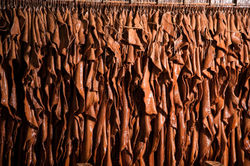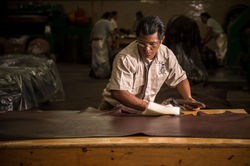
THE TANNING PROCESS
We been producing full grain, vegetable tanned leather for over 85 years. The artisanal tanning process takes nearly 45 days and is what makes vegetable leather much different from leathers produced using other types of tannages. Our slow and time-honored vegetable tanning process using jumbo, heavy native steer (from the United States and Canada) sets our leather apart.
Proceso de Curtido
Preparing the Hides
When the Jumbo Heavy Native Steer hides arrive from North America (the United States and Canada) they are re-hydrated, de-haired and other operations are preformed to prepare the hides for the tanning process.
 |  |  |  |  |
|---|---|---|---|---|
 |
Vegetable Tanning
The hides are vegetable tanned using the traditional method of pit-drums filled with a blend of vegetable tannins and extracts. These are exacted with from trees such as quebracho, chestnut, mimosa, and acacia trees.
The hides will remain in these pits for about 30 days. Tanning the leather for a long period of time gives the leather an unbeatable richness. After tanning in the pits, the hides are now considered leather.
 |  |  |  |  |
|---|---|---|---|---|
 |  |
Oiling and Finishing
Some of the leather is then dyed in large drums and then oiled. The oiling process makes the leather flexible and soft.
The hides are then are taken through the setting out process to smooth out wrinkles. The excess liquid is then removed from the sides using a samming machine. After this is complete, each piece is stretched out and cleaned by hand.
The leather is then sent to the drying chambers where humidity and temperature are controlled to allow the leather to dry slowly.
Some leathers may require a final finish depending on the look desired and the use of the leather products that will be made using the leather. After the finishing is complete, the leather is ready to be used to make leather goods that can last a lifetime.
 |  |  |  |  |
|---|



